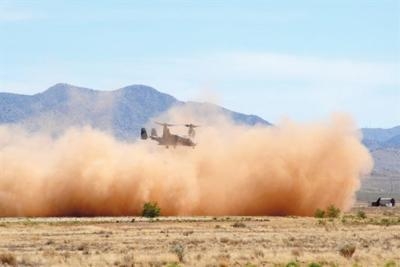Biodegradable Substance Holds Dust Down In Practice Landing Zones
The 58th Special Operations Wing has a plan to mitigate aircraft engine damage that happens during training missions using a biodegradable binding material at practice landing zones.

TerraLOC — a material is described to 58th SOW officials as "Gorilla Glue on steroids," by its manufacturer -- binds the dirt in a landing zone together so it doesn’t stir up as much when a CV-22 Osprey lands.
Avoiding the damage caused by New Mexico's dirt is the key to saving money and getting Airmen trained, said Col. Dwight Davis, the 58th Operations Group commander. "Any dust mitigation extends the life of the engine and the prop-rotors," Davis said. "Starting at about 50 or 60 feet, it's like having two Category 5 hurricanes coming down."
The dirt in New Mexico presents a special problem for CV-22s. The abundant minerals found here, such as quartz and pumice, are abrasive and damage engines and prop-rotors, even more than the dirt and sand in places like Afghanistan. A visual inspection of the Ospreys, specifically the nicks and dings on the prop-rotor leading edges, tells the story of what dirt can do to aircraft, he said.
Having the aircraft in good repair and available for training missions is necessary for the 58th SOW, which trains Airmen for special operations missions. "We're concerned about the man hours involved in taking an engine down, taking the aircraft out of service and not having it available," Davis said.
Replacing an engine in a CV-22 costs around $1.2 million, said Lt. Col. Christina Willard, the 58th Operations Support Squadron commander. Applying TerraLOC, which costs about $70,000 for the initial treatment and less for subsequent applications, makes sense in terms of money and maintenance time.
According to Willard, TerraLOC could also save the wing nine engine replacements a year. In addition to saving money on equipment, the Air Force must also help preserve the environment and the public lands used for landing zone practice.
To help find a solution, the 58th SOW worked closely with the Bureau of Land Management (BLM), which owns the land the Air Force uses as practice drop zones. "To work with the BLM, you can't do anything to the environment," Willard said.
The BLM approved use of TerraLOC after a one-year trial. TerraLOC will be initially used at two drop zones, with plans to add more drop zones in the future. "One of the main reasons we went with TerraLOC is that, once we are no longer using a landing zone, (the land) goes back to the way it was before," Davis said. The biodegradable nature of TerraLOC was a big selling point.
However, to be effective, TerraLOC must also be reapplied every 6-8 months, Willard said. Davis added that rain actually helps an application remain viable for longer. New Mexico's dry weather makes more applications necessary.
(USAF Image)
 NTSB Prelim: Piper PA-23
NTSB Prelim: Piper PA-23 ANN FAQ: Submit a News Story!
ANN FAQ: Submit a News Story! Classic Aero-TV: One Mans Vietnam
Classic Aero-TV: One Mans Vietnam ANN's Daily Aero-Linx (07.03.25)
ANN's Daily Aero-Linx (07.03.25) ANN's Daily Aero-Term (07.03.25): High Speed Taxiway
ANN's Daily Aero-Term (07.03.25): High Speed Taxiway



